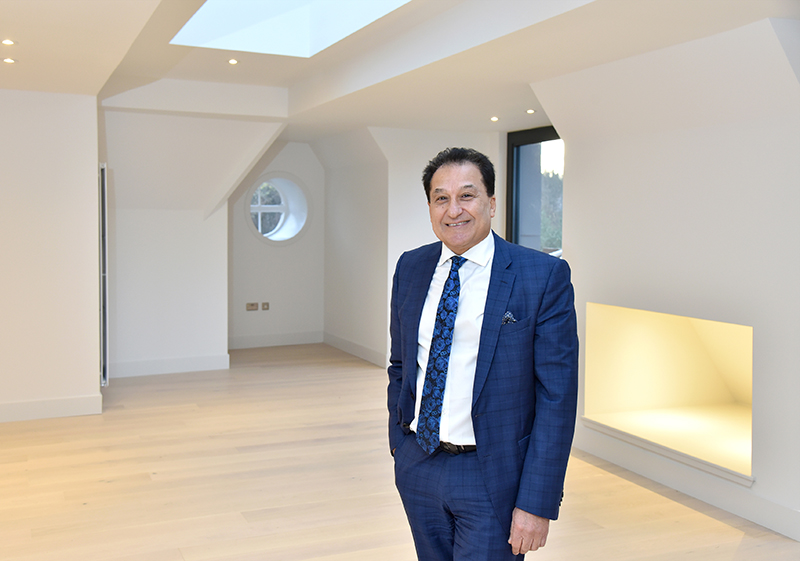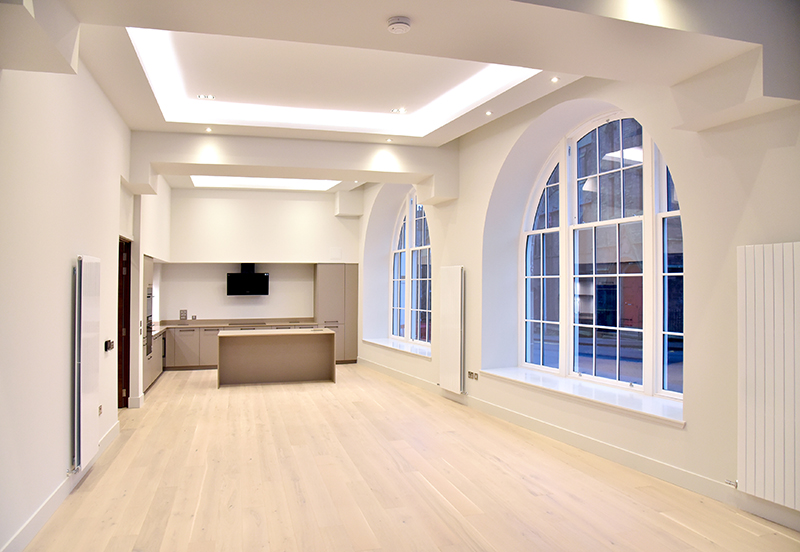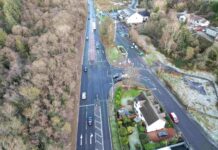
LUXURY property developer AMA has vowed to continue delivering unique projects that add value to communities in and around Edinburgh, as the group’s latest site on the edge of Dean Village starts to take shape.
AMA was founded in 1983 by brothers Mike and Ali Afshar, with a mission to create inspirational properties that complement the heritage of Scotland’s capital.
The brothers, who have a background in chartered surveying and structural engineering, respectively, initially specialised in sympathetically restoring older properties in Edinburgh’s New Town, combining traditional features with local materials and modern fixtures and fittings. They were soon joined by younger brothers Behzad and Behnam to drive other disciplines within the company. In the last decade, younger second generation Bobak and Parissa have joined, bringing energy and new ideas and support to the team.
AMA’s portfolio of restoration projects includes the transformation of the B-listed former Marchmont School into stylish apartments and ground floor commercial space; Springwell, which involved converting a former hospital into residential space; and Torwood, where 23 luxury homes have been created across two pavilions within the grounds of a Victorian villa.
The company extended its expertise into new developments in Edinburgh’s World Heritage Sites, regeneration of Fountainbridge, and contemporary residential and commercial projects. AMA’s first ever new-build property development launched in the mid-1990s and the business has since filled a number of important gap sites, including at Ravelston, Murrayfield, and Inverleith.
The firm has established a reputation for successfully combining the restoration of historic buildings and the surrounding grounds with new-build elements.
That combination of the old and the new can be found at AMA’s latest project – Village View, located at the intersection of Edinburgh’s New Town and Dean Village. Once complete, the project will feature 45 apartments and three townhouses. The homes are spread across three blocks – two brand-new buildings and the conversion of a former coach works.
“We treat old buildings as very close to our heart,” Mike Afshar told Project Scotland, revealing that care is always taken to retain façades and other elements of historic structures.

The business has tackled everything from residential and commercial projects to student accommodation and even an aparthotel.
A milestone moment came at the turn of the century, when AMA teamed up with Bryant Homes on a joint venture to develop the site of the former Dunfermline College of Physical Education in Cramond.
“We saw a huge shortage of top-quality housing in Edinburgh,” Mike Afshar added. “We won the bid for the Dunfermline College of Physical Education at Cramond and created a scheme of detached housing, crescent houses, townhouses, and flats. We engaged with Richard Murphy Architects for this particular project because of their expertise in contemporary architecture. We work with seven or eight different firms of architects in Edinburgh. We pick whoever is appropriate for each site, who can bring out our vision of delivering that.”
Mike built a contemporary house in The Grange area for himself, which allowed him to trial new technologies and analyse the capability of the local supply chain.
“The components selected for building a contemporary house are extremely important,” he explained. “Our ethos has always been not to just build a development and look at the bottom line and move on; it has to be sustainable and something that stands the test of time.”
The Cramond site was perfect for AMA as it involved multiple phases, meaning there wasn’t pressure to build too many units at once – a major consideration for a firm which puts huge emphasis on quality and quality control.
Other landmark projects have included the award-winning 71-unit St Vincent’s Place, 3-4 McEwan Square on the site of the former Fountainbridge Brewery, Slateford, Mount Alvernia convent redevelopment, Kinnear Road, Falcongate in Morningside, and many more.
On the commercial side, AMA’s work includes Evolution House, a building on the corner of West Port and Lady Lawson Street, constructed on a site that had been used as a car park by the Edinburgh College of Art (ECA). Working with Reiach and Hall, AMA created a six-storey facility that was initially intended for office use before ECA bought the building back as an annexe to its campus.
“The vision has always been to create something different,” Mike added. “We don’t want to do the same thing twice. We look at what the market needs, move with it, and provide something that is going to add value.”

Whatever the project, AMA’s approach to development remains consistent. The ethos is to find the right site and complement that with the right design that is bespoke to each location.
“We’ve got our own internal control mechanism,” Mike added. “We have three architects and four in-house surveyors. We consider the design information from consultants engaged on each development and assess whether it’s buildable, whether it needs value-engineered, and so on. I don’t know of any other developer that does that. I think it makes a huge difference in the delivery of the product.”
Mike listed current trends in the luxury housing market as including eco-friendliness, close proximity to amenities, lift access, plenty of storage, underfloor heating, good airtightness, quality design, on-site parking, and external spaces.
Since the pandemic, working from home has become more commonplace, necessitating the need for properties with workspaces. AMA was ahead of the game in this regard, having prioritised such spaces long before anyone had ever heard of Covid-19.
“We created the flats at Cramond with workspaces,” Mike revealed. “By the turn of the century and thereafter, everybody was living on their laptops. We could see the direction. Wherever we could, we’ve included study space.”
AMA prides itself on delivering products that are snag-free. The firm doesn’t venture far from Edinburgh as Mike and Ali are completely hands-on, visiting sites on a weekly basis and familiarising themselves with every stage of development.

“I would like to think that things don’t get past our eyes, and even if they did, we have got a number of people that have been with us for a number of years,” Mike continued. “Our staff enjoy working with this ethos. They are like our family. The workforce who come here know they wouldn’t get away with cutting corners. Doing it correctly once is better than going back and repairing.”
Mike believes there are ‘huge benefits’ to being a family business, including a speedy and streamlined decision-making process, as well as the flexibility to be able to adapt quickly to market changes.
“The better thing is the synergy we have as a family,” he added. “My brother and I are only 20 months apart and we’ve always been close in our decision-making process. We act like twins! We tend to agree on most things all the time, and that’s why we’ve managed to run this business successfully.
“I think having a family business is better than having a big board. I compare our board as a speedboat compared to a tanker.”
Having been in business for over 40 years, AMA has built up a healthy supply chain of trusted partners. The firm engages with organisations of all sizes and has become an important local provider of work for sub-contractors.
With Scotland having declared a housing emergency, Mike has strong views about the situation. He’d like to see a less restrictive planning process, highlighting that plans to include a minimum of 35% affordable homes will not be suitable in all cases. He also cited the length of time it takes to secure things like scaffolding permits, which can create delays and negatively impact funding.
Sites like Village View – which is scheduled for completion in spring 2025 – will play its part in keeping the housing market moving, with the apartments proving particularly popular with downsizers looking to leave larger properties but remain close to city centre amenities.
The development was described by Mike as one of the most demanding AMA has ever embarked upon, not least because the central location on Belford Road has created logistical challenges; from traffic management and changing building regulations to ensuring deliveries happen at set times on a site where access is limited, and lorries have to manoeuvre up and down a narrow lane.
“This is probably one of the most difficult projects we’ve delivered,” Mike stated. “We’ve built a non-combustible core within the old building. We had to take the lift shaft below the foundation. We’ve had a number of challenges thrown at us since we obtained planning permission. There have been changes to U-values associated with buildings and even getting consent for putting new windows for the former coach works/showroom building required non-material planning variation. Although this is not a listed building, it is within a conservation area.
“The challenges have been quite significant. But it’s been very worthwhile. Given the fact we bought the site in 2001 for investment and knew there was a 60s building there that didn’t add any value, we always thought there was a potential to do something nice. I think in the next couple of months we’ll see the scaffold come off and the new architecture will be unveiled. I’m very pleased with the way it’s looking.”
Looking to the future, AMA has a strong pipeline of projects including the delivery of top end housing at South Queensferry which the business is working on with renowned architect Tony Kettle, and a sports-led development in the next phase at Cramond.
AMA also has plans to create an intergenerational facility and sports hub, and a later living village. Aimed at people 55 and over, the idea is to support independent living and design a community with a village centre boasting amenities such as restaurants, leisure facilities, and shops. The model has proved popular overseas and south of the border but is not currently being provided in Scotland to any large degree.
The ambition underpinning the process for all future ventures will remain the same.
“We don’t only think about making a profit and moving on; anything we do has to add value to the surrounding community,” Mike concluded. “We’re very much about legacy. We are very proud of our product and will stand by it.”











